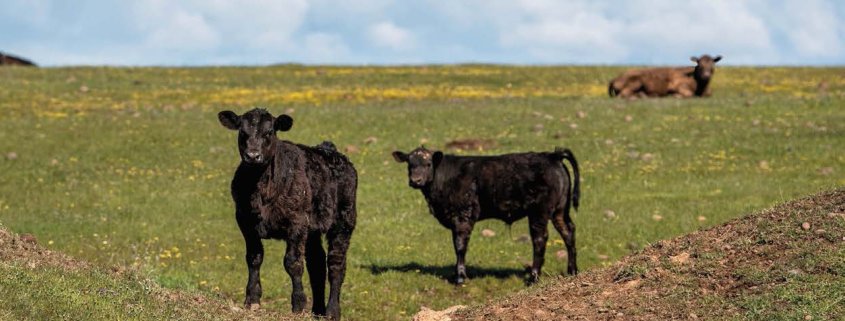Grass-Fed Beef
By BARRY ESTABROOK | PHOTOS BY CANDICE VIVIEN
I lost my appetite for mass-produced, grain-fed beef about a decade ago while speeding along Interstate 5 in California’s Central Valley on a cloudy winter afternoon. My epiphany came as I passed a feedlot. Occupying more than a square mile, the complex of fences and feed troughs could accommodate up to a quarter of a million cattle. They spent the last months of their lives in fetid conditions jammed together shoulder-to-shoulder on top of their own excrement and, depending on the season, goopy mud or a haze of thick brownish dust. I could not see a single blade of grass. Most memorable, however, was the putrid sulfurous stench. It somehow seeped in through the closed window of my car miles before I passed the feedlot and lingered long afterward.
I didn’t want that memory to come between me and my grilled sirloins, so I switched almost exclusively to the meat of grass-fed cattle, who live their entire lives grazing on open pasture, as cows are meant to do. In part, I made the change for reasons of animal welfare, but I have learned that going grass-fed also contributed to my own welfare.
A few years ago, I joined about 100 farmers, chefs, and academics at a conference that convinced me of the healthful benefits of grass-fed beef at the Stone Barns Center for Food and Agriculture just north of New York City for the release of a detailed report on grass-fed beef titled “Back to Grass.” Citing many studies, the report’s authors concluded, “Pasture-raised, grass-fed beef is healthier than conventional grain-finished, especially when grass-fed cattle have access to healthy, ample, and diverse pasture.”
For starters, grass-fed beef contains less than half the total fat per serving of grain-fed, according to an analysis undertaken by Susan Duckett of Clemson University, and contains far higher percentages of so-called “good” fats. Although grass-fed and grain-fed meat contain the same amounts of saturated fat, which the American Heart Association says should be restricted because it can increase cholesterol levels in the blood, not all saturated fats have the same impact. Studies show that grain-finished beef has much more myristic and palmitic fatty acids, both of which raise cholesterol. Grass-fed is higher in stearic acid, which does not raise cholesterol levels.
An extensive review led by Cynthia Daley of the University of California Chico published in Nutrition Journal in 2010 reported that research spanning three decades consistently suggests that “grass-only diets can significantly alter the fatty composition and improve the overall antioxidant content of beef.” Antioxidants prevent damage to cells.
She went on to conclude, “Regardless of the genetic makeup gender, age, species, or geographic location [of cattle] direct contrasts between grass and grain rations consistently demonstrate significant differences in the overall fatty acid profile and antioxidant content found in their lipid deposits and body tissues.”
Like many, I take a daily supplement of fish oil to make sure I’m getting adequate amounts of beneficial omega-3 fatty acids, which tend to be lacking in the typical North American diet. But research indicates that I would almost certainly be better off skipping the pills and getting my omega-3s from a well-balanced diet, including fatty fish and, as it turns out, grass-fed beef.
According to Daley, omega-3 acids can play a crucial role in preventing heart disease, arthritis, hardening of the arteries, and cancer. They even lower the incidence of depression, memory loss, and Alzheimer’s disease. Grass-fed beef contains higher concentrations of omega-3 acids than grain-fed.
Cattle are designed to eat grasses, not grain. Putting them in a feedlot with a diet of grain raises the acidity of their digestive systems, which reduces the production of compounds called conjugated linoleic acids (CLAs) by a factor of three, compared to production in animals that eat lush green grass. Numerous animal studies have shown that CLAs can prevent cancers and hardening of the arteries, as well as slow the onset of type-2 diabetes. Some research indicates that CLAs might even help obese humans lose body fat.
Grass-fed beef is also packed with vitamins. Beta-carotenes are precursors to vitamin A, which is important for good vision, bone growth, healthy skin and mucous membranes, and immune function. In a 2005 article in the journal Meat Science, a group of Argentinian researchers led by Adriana Descalzo reported that grass-fed beef delivered fully seven times as much beta-carotene as grain-finished. Similarly, grass-fed beef was found to contain nearly three times as much vitamin E, which protects against heart disease and cancer.
As you can imagine, cramming cattle together by the tens, or even hundreds, of thousands on vast feedlots and forcing them to eat an unnatural diet of grain leaves them susceptible to a range of pathogens—some of which might land on your countertop and plate.
To keep animals in their care from getting sick, three quarters of large feedlot operators routinely feed antibiotics to their cattle, even those that are perfectly healthy, “as a health and production management tool,” in the words of the U.S. Department of Agriculture. This practice creates ideal conditions for the development of antibiotic-resistant germs, which some of the most potent drugs in the modern medical arsenal cannot destroy—so-called superbugs.
The acidic conditions in the guts of grain-fed cattle not only hamper production of beneficial fatty acids, but make the animals perfect incubators for E. coli 0157:H7, a bacterium that has evolved to tolerate the acidity of our own stomachs. Although it does not sicken cattle, resistant E. coli from feedlots can spread to humans, either on meat brought home from the store or via contaminated air and water. The result is one of the most worrisome foodborne diseases in the country. E. coli infections can cause nausea, bloody diarrhea, kidney failure, and in some cases lead to a long, lingering death, not a great ad for one of Americans’ favorite meats.
In its 2015 “Beef Report,” Consumer Reports revealed that laboratory-tested samples of beef produced on feedlots were twice as likely as sustainably produced samples to carry bacteria resistant to two or more classes of antibiotics. Three different strains of MRSA, a potentially fatal, drug-resistant Staphylococcus bacterium, were found on conventional meat; none on sustainably produced cuts. Overall, grass-fed specimens had a three times lower likelihood of carrying any resistant bacteria compared to conventional.
As Frederick Provenza of Utah State University reported in the journal Frontiers in Nutrition, “Animals foraging on phytochemically diverse pastures require less anthelmintics [drugs that kill parasites] and antibiotics than animals foraging on monoculture pastures or in feedlots.” In short, pastured cows are healthier than those stuffed with grain. Every month or so my wife and I indulge in a proudly all-American dinner. The menu consists of a wedge of iceberg lettuce with a buttermilk-based blue cheese dressing, oven-baked potato wedges, and hamburgers. It’s thoroughly retro in every way but one: The burgers are made from American-raised grass-fed beef. It’s nice to know that the meat contains only 10 percent fat. And since we tend to err on the rare side when we grill burgers, we like the security of knowing that the patties between the buns are very unlikely to come with a side order of pathogens.
But in the end, what keeps us coming back is the flavor: tangy, moist, and deliciously beefy. Perfect, when all you want is a burger that is truly good—in all respects.
Visit our friends @ https://panoramameats.com/ for more info on things like who is raising the beef, how they are raised and product availabe.

